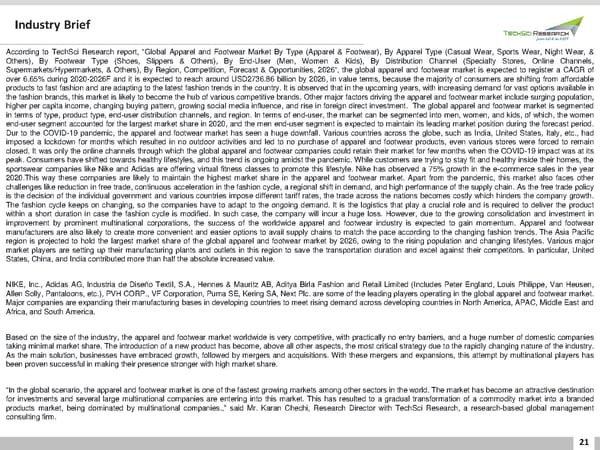Industry Brief According to TechSci Research report, “Global Apparel and Footwear Market By Type (Apparel & Footwear), By Apparel Type (Casual Wear, Sports Wear, Night Wear, & Others), By Footwear Type (Shoes, Slippers & Others), By End-User (Men, Women & Kids), By Distribution Channel (Specialty Stores, Online Channels, Supermarkets/Hypermarkets, & Others), By Region, Competition, Forecast & Opportunities, 2026”, the global apparel and footwear market is expected to register a CAGR of over 6.65% during 2020-2026F and it is expected to reach around USD2736.86 billion by 2026, in value terms, because the majority of consumers are shifting from affordable products to fast fashion and are adapting to the latest fashion trends in the country. It is observed that in the upcoming years, with increasing demand for vast options available in the fashion brands, this market is likely to become the hub of various competitive brands. Other major factors driving the apparel and footwear market include surging population, higher per capita income, changing buying pattern, growing social media influence, and rise in foreign direct investment. The global apparel and footwear market is segmented in terms of type, product type, end-user distribution channels, and region. In terms of end-user, the market can be segmented into men, women, and kids, of which, the women end-user segment accounted for the largest market share in 2020, and the men end-user segment is expected to maintain its leading market position during the forecast period. Dur to the COVID-19 pandemic, the apparel and footwear market has seen a huge downfall. Various countries across the globe, such as India, United States, Italy, etc., had imposed a lockdown for months which resulted in no outdoor activities and led to no purchase of apparel and footwear products, even various stores were forced to remain closed. It was only the online channels through which the global apparel and footwear companies could retain their market for few months when the COVID-19 impact was at its peak. Consumers have shifted towards healthy lifestyles, and this trend is ongoing amidst the pandemic. While customers are trying to stay fit and healthy inside their homes, the sportswear companies like Nike and Adidas are offering virtual fitness classes to promote this lifestyle. Nike has observed a 75% growth in the e-commerce sales in the year 2020.This way these companies are likely to maintain the highest market share in the apparel and footwear market. Apart from the pandemic, this market also faces other challenges like reduction in free trade, continuous acceleration in the fashion cycle, a regional shift in demand, and high performance of the supply chain. As the free trade policy is the decision of the individual government and various countries impose different tariff rates, the trade across the nations becomes costly which hinders the company growth. The fashion cycle keeps on changing, so the companies have to adapt to the ongoing demand. It is the logistics that play a crucial role and is required to deliver the product within a short duration in case the fashion cycle is modified. In such case, the company will incur a huge loss. However, due to the growing consolidation and investment in improvement by prominent multinational corporations, the success of the worldwide apparel and footwear industry is expected to gain momentum. Apparel and footwear manufacturers are also likely to create more convenient and easier options to avail supply chains to match the pace according to the changing fashion trends. The Asia Pacific region is projected to hold the largest market share of the global apparel and footwear market by 2026, owing to the rising population and changing lifestyles. Various major market players are setting up their manufacturing plants and outlets in this region to save the transportation duration and excel against their competitors. In particular, United States, China, and India contributed more than half the absolute increased value. NIKE, Inc., Adidas AG, Industria de Diseño Textil, S.A., Hennes & Mauritz AB, Aditya Birla Fashion and Retail Limited (Includes Peter England, Louis Philippe, Van Heusen, Allen Solly, Pantaloons, etc.), PVH CORP., VF Corporation, Puma SE, Kering SA, Next Plc. are some of the leading players operating in the global apparel and footwear market. Major companies are expanding their manufacturing bases in developing countries to meet rising demand across developing countries in North America, APAC, Middle East and Africa, and South America. Based on the size of the industry, the apparel and footwear market worldwide is very competitive, with practically no entry barriers, and a huge number of domestic companies taking minimal market share. The introduction of a new product has become, above all other aspects, the most critical strategy due to the rapidly changing nature of the industry. As the main solution, businesses have embraced growth, followed by mergers and acquisitions. With these mergers and expansions, this attempt by multinational players has beenprovensuccessfulin making their presence stronger with high market share. “In the global scenario, the apparel and footwear market is one of the fastest growing markets among other sectors in the world. The market has become an attractive destination for investments and several large multinational companies are entering into this market. This has resulted to a gradual transformation of a commodity market into a branded products market, being dominated by multinational companies.,” said Mr. Karan Chechi, Research Director with TechSci Research, a research-based global management consulting firm. 21
 GLOBAL APPAREL AND FOOTWEAR MARKET FORECAST & OPPORTUNITIES Page 20 Page 22
GLOBAL APPAREL AND FOOTWEAR MARKET FORECAST & OPPORTUNITIES Page 20 Page 22